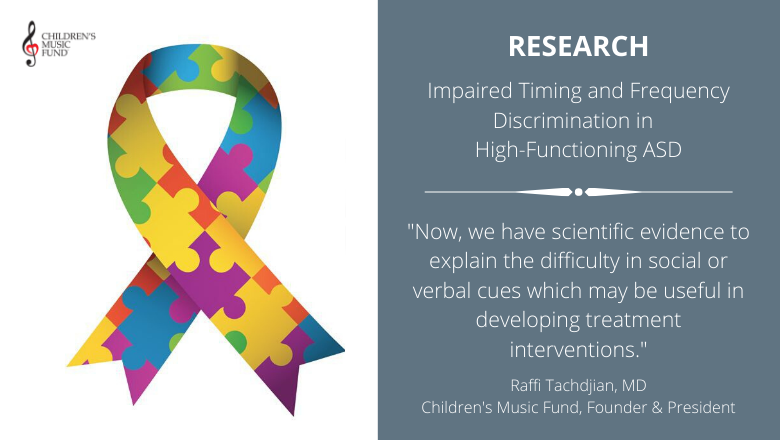
June 21, 2020 | Blogs and News
By Vicky K. — Summary of research co-sponsored by Children’s Music Fund: Impaired Timing and Frequency Discrimination in High-Functioning Autism Spectrum Disorders, as published in Journal of Autism & Developmental Disorders
According to the CDC, 1 in 59 children have been identified with Autism Spectrum Disorder (ASD). It is prevalent in all ethnic groups however boys are four times more likely to be affected. People affected with ASD can range from high functioning to severely affected, and may have difficulty with social interactions, speech and language comprehension, and sensory problems. They can also overreact to sensory stimuli, sometimes being affected by the softest sounds. Although studies show evidence of atypical auditory processing in ASD, many questions pertaining to where this atypicality arises have thus been unanswered.
Testing Methodology
In 2013, Children’s Music Fund in collaboration with Dr. Anjali Bhatara studied two different auditory processes in patients with a high functioning Autism Spectrum Disorder. The team focused on two tasks in order to delineate two different processes involved in auditory processing: 1) impaired timing; and 2) frequency discrimination. Impaired timing was used to distinguish a patient’s temporal auditory cues, while frequency discrimination was used to determine a subject’s spectral cues.
Temporal cues are the onset times in speech, which form the known linguistics of a language, while spectral cues typically are composed of a pitch pattern. These two types of cues are then processed together to provide important information such as speech recognition, speaker identification and sound localization. Many patients with ASD exhibit an impairment or enhancement in one or the other and this study takes a deeper look at these cues. There were no significant differences in hearing thresholds or ear function between the groups.
Frequency discrimination and gap detection were measured by having each subject determine which stimulus was different from the others via the use of buttons and lights. Each subject was also given a Words-in-Noise test, in which participants repeated words that were previously given in the task over a background noise. The correct number of words is used to create a speech-to-noise ratio for speech identification.
Results
The Bhatara and Children’s Music Fund research team discovered that the ASD group required a significantly higher speech-to-noise ratio than the control group to understand the words presented. The ASD group also had higher average gap detection thresholds than the control group. However, the stimulus type appeared to affect the gap detection threshold for the ASD group, who showed a better performance with noise stimuli as opposed to pure tones.
In another impactful discovery, this study demonstrated that as frequency increased, the ASD group’s thresholds increased at a faster rate than the control group. Thus, the ASD group was significantly impaired at higher frequency discrimination. When split by sensitivity, the hyper-sensitive group exhibits a similar pattern. The timing perception task was analyzed in a similar fashion.
The results depicted that the thresholds from the ASD group were higher than the control group, suggesting that ASD subjects have more difficulty detecting small gaps of silence, and have impaired temporal perception. Dr. Raffi Tachdjian, one of the authors of the paper and a member of Children’s Music Fund research team stated:
This may explain the basis of behavioral patterns in individuals with ASD. Now, we have scientific evidence to explain the difficulty in social or verbal cues which may be useful in developing treatment interventions.
Connection to Music Therapy
While this study aims to understand the perceptual functioning in adolescents with ASD compared to their TD counterparts, you may wonder where in lies the relevance to Music Therapy. It has been shown that Music Therapy can build trust, alleviate anxiety, as well as help with communication skills in people living with ASD. Those who struggle with sensory aversions and who cope with sound sensitivities are not to be ruled out. Data shows that these individuals can also benefit from Music Therapy when working with a board-certified Music Therapist that can develop strategies specific for the individual.
Children’s Music Fund continues to investigate the role of Music Therapy in children suffering from various health ailments, including those who live with autism. Through donations, Children’s Music Fund is able to fully-fund Music Therapy services and continue to sponsor research to provide the most up-to-date modes of Music Therapy to sick children in need. Learn how you can get involved with our CMF Kids community by joining the One Heart Fan Club here. Together, we can Spread the Love and help children living with autism. Make a difference in the life of a child, donate today.
To read the entire research study, click here.
